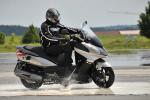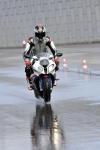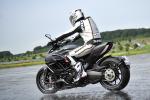Bosch ABS testing
By Kevin Ash - 04/10/2012
The adoption of ABS on bikes is years behind the car world. Across Europe only a third of bikes over 250cc is fitted with it, while one in 33 smaller two wheelers have ABS. Yet almost all new cars have it, so what‘s going on?
Bike riders themselves have been resistant to ABS, perceiving it as a hindrance rather than aid where performance is concerned, especially as early systems increased braking distances substantially. There is a truth in this, and there are technical issues in fitting ABS to motorcycles which don‘t apply to cars. The pulsing action of ABS means it can‘t safely operate while a motorcycle is leaning over as the bike can still lose grip, especially at the front wheel, which means riders are told not to attempt to steer while the ABS is operating. In contrast, one of the main points of ABS in a car is to allow the driver to steer around an obstacle while emergency braking.

Cost is a major factor, if only because motorcycles are cheaper than cars to start with. The ABS systems required by both are much the same, but its £500- £800 cost is much more easily absorbed into a £20,000 car‘s price than a £5,000 motorcycle. Combine that with many riders being unconvinced by its benefits and you have little incentive for expanding its usage.

For designers though there are other issues, the primary one being size. Early motorcycle ABS systems were big: the first Bosch one was produced in 1994 and utilised a control unit and pump the size of a melon, weighing 10lb (4.5kg). Finding space for this on most motorcycles was very difficult, which is why the design focus has always been on reducing the weight and dimensions, especially as bikes themselves have been getting smaller and lighter.
The latest ninth generation Bosch ABS 9 is little bigger than a tennis ball and it weights 1.5lb (0.7kg), a much less daunting prospect to tuck inside a motorcycle‘s chassis.

It‘s this which I tried out on a range of bikes at Bosch‘s proving ground in Boxberg, Germany. Bosch laid out a series of extreme test, including heavy braking across a patch of sand, braking hard while moving from a dry, grippy surface to slippery wet cobblestones, ferocious maximum braking on ABS-equipped high end superbikes on high grip surfaces (S1000RR and ZX-10R), and trying to stop on a surface with the grip of polished ice. Not ordinary ice, polished ice...
In every case the ABS coped perfectly, preventing wheel lock up in the most extreme circumstances, and stopping the bike surprisingly rapidly even on the slippery surfaces, and dealing impeccably with the dramatic changes in surface.

But I still needed to exercise some control of my own, partly in some cases because of the bike but also for a more personal reason... Modern tyres offer so much grip that the limiting factor is often not wheel lock up but the bike tipping over its own front wheel... a stoppie. Some ABS systems are fed additional information about the pitch of the bike by highly sensitive solid-state gyros, and when the rear wheel rises too far, the front brake is released to reduce the chance of tipping over forwards.

This happens more readily on tall bikes such as the SM-T, but I had persistent problems too with the S1000RR. The system slowed down the rate at which the bike was lifting the rear wheel, but I still had to release the front brake manually to prevent it occurring. And that was my fault too, for being 6‘3”� (1.91m) tall... My own centre of gravity is significantly higher than shorter riders‘ and because of this, the bike was lifting the rear wheel with me where with others it was hardly doing so at all. I was better on the ZX-10R because there‘s more room and I could slide back on the seat and lower myself, but the BMW‘s more compact ergonomics prevented me from doing this. The lesson is, if you want to outbrake someone, look for a tall rider...

The same applies to the bikes themselves. The SM-T and Diavel were both demonstrated on the high-to-low grip section, and where the KTM was skipping and hopping, and lifting its wheel enough at times to force me to let go of the lever, the Ducati just hunkered down and slewed to a halt with absolutely no fuss or drama. This is because it has a long wheelbase and low centre of gravity, both of which mitigate against lifting the rear wheel. It also has fiercely powerful Brembo Monobloc calipers, and the combination of all of this means the Diavel offers the most powerful braking Bosch has ever measured on a motorcycle. It was so fierce as a prototype in fact that Ducati asked Bosch to tame the ABS slightly, bringing the 1.1g average stopping force down to just under 1g with the best of the rest, as it was so shockingly hard many riders were being thrown forward and were in danger of losing control!
In any of these circumstances I could not beat the ABS system. In dry and grippy conditions I was dealing with rear wheel lift before the ABS was coming into play anyway, while its response to sudden surface changes was far faster and more accurate than I could manage. If those had cropped up in an emergency, I‘d have been off.

The next generation of ABS, being worked on by Bosch right now, promises finally to cover that problem of steering and braking simultaneously. A level of sophistication is being added which uses technology from Bosch‘s traction control systems, comparing front and rear wheel speeds, with further input from attitude gyros. This will mean the last area of riding not covered by electronics, braking into a turn, will now have a computer control option. Bosch says this is 18 months away, which means it‘s likely to be unveiled in just over a year, possibly on an upgraded S1000RR.
Donate to the Kevin Ash Fund
Kevin's funeral was held on Thursday 28th February 2013 and was well attended by family, friends and colleagues.
The Telegraph has very kindly established The Telegraph Kevin Ash Fund to assist with the education of Kevin's three daughters.
If you'd like to make a donation then you can use the PayPal 'Donate' button below which will allow you to donate from your PayPal account, or via credit or debit card. A small percentage (about 3.4%) will be retained by PayPal for the service.
Kevin's family have been touched by the generosity and messages of support from people using the website and would like to express their gratitude to those who have contributed in any way.
The donations keep coming in, thank you so much, and the family especially like it when you leave a message.
Home | ![]() facebook.com/KevinAshFund
|
facebook.com/KevinAshFund
| ![]() twitter.com/KevinAshFund | © 2012
twitter.com/KevinAshFund | © 2012